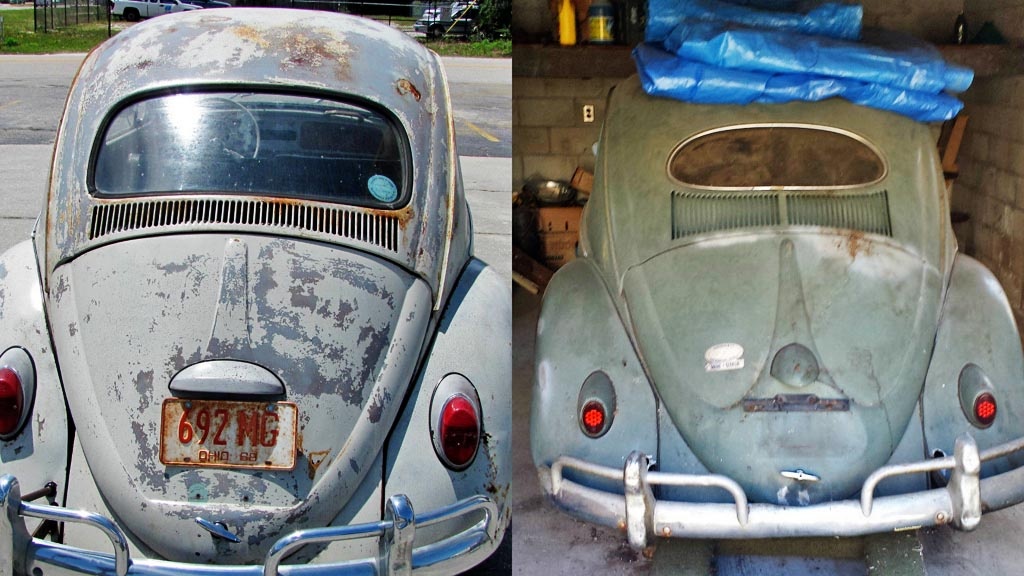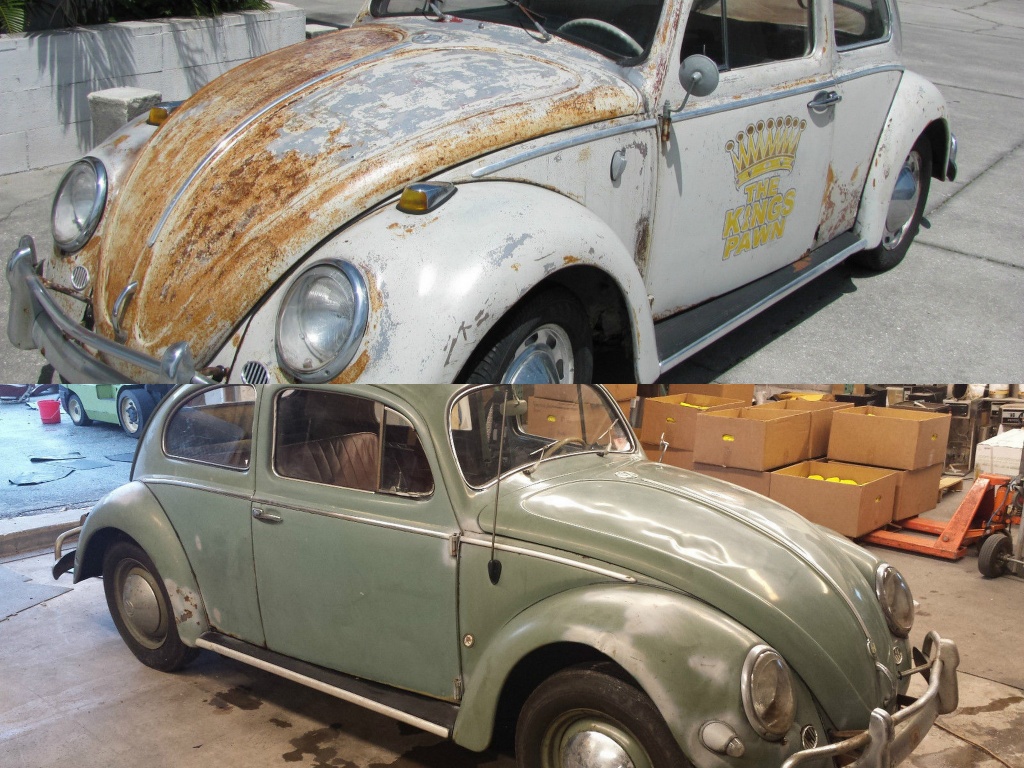We have seen the VW Beetle compared to a number of cars, but one comparison we have yet to see is one between the generations of the Beetle. While we don’t typically think of the Bug as having various generations, there are several distinct changes that could denote a new generation. When we came across two Bugs, one an oval window and the other a later rectangular window, we thought why not do a comparison? Now this isn’t your typical comparison and is probably better classified as a look at the Beetle’s evolution. Let’s start out by looking at our participants. Find the 1958 here on eBay and the 1964 here on eBay.

Car production has evolved considerably since the advent of the mass produced automobile, but the actual cars don’t seem to evolve the same way they use to. Today, a car might evolve from its predecessor’s design, but typically they have short life spans with more frequent complete redesigns. The Beetle is the perfect example of how cars use to evolve, with the primary design remaining the same for decades. And as flaws were discovered or the design lost its appeal, small changes were made to it. A great example of this evolution was the Beetle’s rear window. When the car was first introduced, it had a split (two piece) oval window. After 4 years, VW decided to improve visibility by making it a one piece oval. This design stayed around for another 4 years and then they introduced the rectangular window, which was then left unchanged for the remainder of Beetle production.

Besides the rear window, there were other subtle changes made to the design. The majority of the changes were cosmetic, such as changes to trim pieces, but there were some mechanical improvements made over the years too. The biggest improvement came when horsepower was increased. Every few years, compression was increased and power output went up. From the 1958 to the 1964, horsepower increased from 36 to 40 hp and every few years it increased a bit more. Since the design saw so few changes, one can easily install an earlier or later motor in their car with little to no issues.

Whether you’re a fan of the Beetle or not, it is definitely interesting to look at how cars used to evolve. We wish manufactures would go back to the days of keeping a design in production for several decades, rather than a few years. Sure it is fun to have a new Mustang or Corvette design every few years, but cars like the Beetle, Saab 96, Citroen 2CV, and a number of classics are great examples of the benefits of keeping a design around. Besides the cars we listed, are there any others you can think of that the design remained more or less unchanged for several decades?




Hindustan Ambassador, Lada 2101-2107, Jeep CJ, Grand Wagoneer, BMC Mini, C3 Corvette, Fiat 500, 600, Volvo 1xx/2xx, Rolls Royce Phantom VI, Silver Shadow, Silver Spirit.
we had a 65 ( which i did not share ) and a 60 bug ( which i did have to share ) at same time. the 60 did not have a gas gauge ( lots of stories there) , no synchromesh on 1st gear( old style transmission which we were able to replaced with full synco trans after welding in a updated front transmission mount) and top speed of about 60mph. the 65 had a gas gauge, full synco trans, and top speed of about 70mph. both were a lot of fun. as for cars that change slowly: mgb, midget/sprite, spitfire, town cars, crown vic/grand marquis and model t come to mind.
I bought a ’62 Beetle for $550 in 1966. It got me through schooling in ultra-snowy / ultra-salty Montreal, and I sold it for $200 eight years later. Capital cost, $50/year, so it was a fantastic deal in transportation, and I still have a lot of respect for that.
But….they all had a similar personality despite differing in detail across years, as Jim S has mentioned. From my experience they all had a similar sound and feel on the road, which was also basically similar to the 356, and even the 912 in certain ways. No surprise there. These cars came out of the same designer’s mind, and they are very different in concept and construction from just about all other cars on the road. I guess I prefer owning cars with a different basic design, so I would not be in the market for another Beetle. But when I see them at Show ‘N Shines they always bring back memories and put a smile on my face.
Both are equally cool. But in this case the 1957 Oval (it’s not a 58. 58 was the first year for the big rear window like the 64 has) is the more worthwhile car to buy.
It’s awesome to see a comparison like this. So many people just assume that all Volkswagen Beetles were the same, but there were some pretty drastic changes between the years. I drive a 1967 Beetle, which is arguably the most distinct single year of VW Bug manufacturing. There are many different one year only parts, and it combines the early 60’s styling with an upgraded 53 horsepower engine and a 12 volt electrical system. If I had to pick between these two, I’d take the ’58. After driving a 60’s bug, I have a special eye for the nuances and differences of the earlier models. I really love the swoops on the decklid on the old one. Either way, these both look like fine bugs!
I’m certain the ’57 is the way more expensive one to buy also.
One of the regrets in my life is not buying my bro-in-law’s ’52 Beetle. He had it restored to drivable condition and it was fun blasting around. The only thing wrong with it is 99 out of 100 drivers would see the semaphores waving and point at it and laugh. I’d definitely put in a set of turn signals.
But wait! It gets better: in all his veedub wheeling and dealing he got a ’52 Porsche engine which he had rebuilt and was always going to swap into the bug.
Ended up selling both as a lot sale for $9500 about ten years ago! Jeeze, that engine alone is worth that now, I think…
Let’s see…. Yugo 45 (started life as the 1971 Fiat 127), 1989 Geo Metro/ modern Pak Suzuki Cultus, Maruti Suzuki 800, Zaporozhetz 968, Early Ford Falcon (produced in South America through the 80’s), Maruti Suzuki Gypsy, Ford Festiva/Mazda 121/Kia Pride/Saipa Pride ( just left production in Iran), VW Caddy pickup (South Africa), Datsun Sunny pickup (South Africa), IFA Sachsenring Trabant 601, Renault 4, Nissan Sentra (B13 chassis)-in continuous production since 1990 (Mexican Tsuru), Post-war Tatras (603,etc.), VW Passat (B2)-1981-2013 (in China as the VW Santana), Toyota Century (original was made from 67-97), Nissan Cedric (Y31) 1987 to present. I wish I could think of more, but that’s all that I can come up with off the top of my head.
Nobody has mentioned the quintessential example; the Porsche 911. It is a perfect example of a car model which has retained the essence of the original design with changes made over the years. When parked side-by-side, the common DNA of both the first year model and current model can be seen. The evolution of the 911 has changed just about everything in and on the car, but the original design is still evident. The Fiat 124/2000/Spider is another example I have not seen mentioned.
Having a Fiat 124 Spider, I was waiting for someone to mention it! They did change a number of things over the years to facilitate the larger engines and to meet crash standards, but most of those things were cosmetic. Even after Pininfarina took over production, they didn’t change much! The 911 is one of the other cars I was thinking of. While there is definite DNA in the modern models, I think they lost a lot of their original character when they switched to water cooled motors. All in all, they have actually done a good job to keep the design fresh, meet modern standards, and keep some of that original style though.
65-77 Bronco
For long running design, the hands down winner is the Citroen 2CV and variants–1948 to 1990, 8,756,000 produced. Also the Citroen Traction Avant–1934-1955, 760,000 produced, the Morris Minor–1948-1972, 1,368,000 produced, and the Renault 4L–1961-1992, 8,000,000 produced.
I’m surprised that no one has mentioned the original Land Rover yet. It’s basically been one straight design evolution from the Series trucks to the “modern” Defender. Along the same vein there’s the Toyota FJ-40 Land cruiser that was produced for something like 30 years virtually unchanged. Also, in post-Soviet Russia who can forget the two indigenous 4×4’s: The Lada Niva and the UAZ 469? So long as we are on utility 4×4’s, the original is also an excellent study in evolution. I am of course referring to the Jeep MB/CJ/Wrangler. The all-time champion though has to go to the most produced motor vehicle in the history of mankind, what else but the Honda Super Cub! It’s been in continuous production since 1958 and over 60 million have been built.
I’m thinking more along the lines of vehicles that actually have interchangeable parts for the duration of their runs. Examples would be the Jeep FSJ with 28 years – Wagoneers and Grand Wagoneers from ’63 – ’91, Gladiators/J10/J20 pickups from ’63 – ’87 and the original Cherokees from 1974 – 1983. Even the Jeep XJ Cherokee had plenty of interchangeable parts throughout its 17 year run from ’84 – ’01 (2005 in China). The CJ5 ran from ’54 to ’83, but I don’t think there is a single interchangeable part between the first and last versions.
The Land Rover didn’t change much from 58 to 83 then they changed the suspension and the front grill moved a few inches and it hasn’t changed since! 83 to 2017.